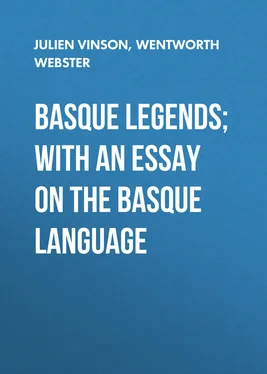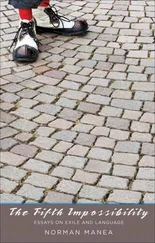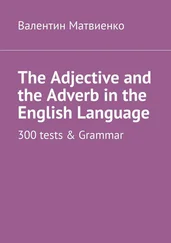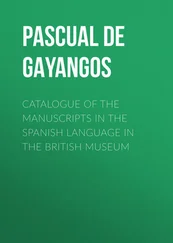Julien Vinson - Basque Legends; With an Essay on the Basque Language
Здесь есть возможность читать онлайн «Julien Vinson - Basque Legends; With an Essay on the Basque Language» — ознакомительный отрывок электронной книги совершенно бесплатно, а после прочтения отрывка купить полную версию. В некоторых случаях можно слушать аудио, скачать через торрент в формате fb2 и присутствует краткое содержание. Жанр: foreign_antique, Старинная литература, Мифы. Легенды. Эпос, на английском языке. Описание произведения, (предисловие) а так же отзывы посетителей доступны на портале библиотеки ЛибКат.
- Название:Basque Legends; With an Essay on the Basque Language
- Автор:
- Жанр:
- Год:неизвестен
- ISBN:нет данных
- Рейтинг книги:3 / 5. Голосов: 1
-
Избранное:Добавить в избранное
- Отзывы:
-
Ваша оценка:
- 60
- 1
- 2
- 3
- 4
- 5
Basque Legends; With an Essay on the Basque Language: краткое содержание, описание и аннотация
Предлагаем к чтению аннотацию, описание, краткое содержание или предисловие (зависит от того, что написал сам автор книги «Basque Legends; With an Essay on the Basque Language»). Если вы не нашли необходимую информацию о книге — напишите в комментариях, мы постараемся отыскать её.
Basque Legends; With an Essay on the Basque Language — читать онлайн ознакомительный отрывок
Ниже представлен текст книги, разбитый по страницам. Система сохранения места последней прочитанной страницы, позволяет с удобством читать онлайн бесплатно книгу «Basque Legends; With an Essay on the Basque Language», без необходимости каждый раз заново искать на чём Вы остановились. Поставьте закладку, и сможете в любой момент перейти на страницу, на которой закончили чтение.
Интервал:
Закладка:
8
See page 192 Конец ознакомительного фрагмента. Текст предоставлен ООО «ЛитРес». Прочитайте эту книгу целиком, купив полную легальную версию на ЛитРес. Безопасно оплатить книгу можно банковской картой Visa, MasterCard, Maestro, со счета мобильного телефона, с платежного терминала, в салоне МТС или Связной, через PayPal, WebMoney, Яндекс.Деньги, QIWI Кошелек, бонусными картами или другим удобным Вам способом.
.
9
There seems to be a Basque root “Tar,” which appears in the words, “Tarro, Tarrotu, v., devenir un peu grand. Tarrapataka, adv., marchant avec précipitation et en faisant du bruit.”—Salaberry’s “Vocabulaire Bas-Navarrais,” sub voce. Cf. Campbell’s “Tales of the Western Highlands,” Vol. II., 94:—“He heard a great Tartar noise,” Tartar being printed as if it were a Gaelic word.
10
Cf. also Müller’s “Fragmenta Historicorum Græcorum” (Didot, Paris, 1841), Vol. I., p. 246. “Ephori Fragmenta,” 51, with the references there given.
11
Cf. also the Gaelic, “The Story and the Lay of the Great Fool,” Campbell, Vol. III., pp. 146–154.
12
This talking giant’s ring appears in Campbell’s “Popular Tales of the West Highlands,” Vol. I., p. 111, in the tale called “Conall cra Bhuidhe.” He also refers (p. 153) to Grimm’s tale of the “Robber and his Sons,” where the same ring appears:—“He puts on the gold ring which the giant gave him, which forces him to cry out, ‘Here I am!’ He bites off his own finger, and so escapes.”
13
Cf. Campbell’s “Mac-a-Rusgaich,” Vol. II., 305:—“I am putting it into the covenant that if either one of us takes the rue, that a thong shall be taken out of his skin, from the back of his head to his heel.”
14
Salamanca was the reputed home of witchcraft and devilry in De Lancre’s time (1610). He is constantly punning on the word. It is because “Sel y manque,” etc. See also the story of Gerbert, Pope Sylvester II., in the 10th century.
15
This incident is found in Cenac-Moncaut’s Gascon tale, “Le Coffret de la Princesse.” “Litterature Populaire de la Gascogne,” p. 193 (Dentu, Paris, 1868).
16
For this incident compare the death of the giant in one of the versions of “Jack the Giant-Killer;” and especially “the Erse version of Jack the Giant-Killer.” Campbell, Vol. II., p. 327.
17
This agreement is found also in the Norse and in Brittany. See “Contes Populaires de la Grande Bretagne,” by Loys Brueyre, pp. 25, 26. This is an excellent work. The incident of Shylock, in the “Merchant of Venice,” will occur to every one.
18
Literally, “Marsh of the Basa-Andre.” The “Puits des Fées” are common in France, especially in the Landes and in the Gironde.
19
Only in this, and one other tale, is the word “prince” used instead of “king’s son.” Compare the Gaelic of Campbell in this respect. This tale is probably from the French, and the Tartaro is only a giant.
20
One of the oddest instances of mistaken metaphors that we know of occurs in “La Vie de St. Savin, par J. Abbadie, Curé de la Paroisse” (Tarbes, 1861). We translate from the Latin, which is given in a note:—“Intoxicated with divine love, he was keeping vigil according to his custom, and when he could not find a light elsewhere, he gave light to his eyes from the light that was in his breast. The small piece of wax-taper thus lit passed the whole night till morning without being extinguished.”—Off. S. Savin.
21
This Fleur-de-lis was supposed by our narrator to be some mark tattooed or impressed upon the breast of all kings’ sons.
22
This, of course, is “Little George,” and makes one suspect that the whole tale is borrowed from the French; though it is just possible that only the names, and some of the incidents, may be.
23
Cf. “Ezkabi Fidel,” 112, below.
24
In Campbell’s “Tale of the Sea-Maiden,” instead of looking in his ear, the king’s daughter put one of her earrings in his ear, the last two days, in order to wake him; and it is by these earrings and her ring that she recognises him afterwards, instead of by the pieces of dress and the serpent’s tongues.
25
Campbell, Vol. I., lxxxvii., 8, has some most valuable remarks on the Keltic Legends, showing the Kelts to be a horse-loving, and not a seafaring race—a race of hunters and herdsmen, not of sailors. The contrary is the case with these Basque tales. The reader will observe that the ships do nothing extraordinary, while the horses behave as no horse ever did. It is vice versâ in the Gaelic Tales, even when the legends are identical in many particulars.
26
The three days’ fight, and the dog, appear in Campbell’s “Tale of the Sea-Maiden,” Vol. I., pp. 77–79.
27
The Basque word usually means “Eau de Cologne.”
28
This is a much better game than the ordinary one of tilting at a ring with a lance, and is a much more severe test of horsemanship. The ring, an ordinary lady’s ring, is suspended by a thread from a cross-bar, at such a height that a man can just reach it by standing in his stirrups. Whoever, starting from a given point, can put a porcupine’s quill, or a small reed, through the ring, and thus carry it off at a hand-gallop, becomes possessor of the ring. We have seen this game played at Monte Video, in South America; and even the Gauchos considered it a test of good horsemanship. Formerly, it seems, the ring was suspended from the tongue of a bell, which would be set ringing when the ring was carried away. The sword, of course, was the finest rapier.
29
One of those present here interrupted the reciter—“What did she hit the serpent on the tail for?” “Why, to kill him, of course,” was the reply; “ask Mr. Webster if serpents are not killed by hitting them on the tail?”
30
I have a dim recollection of having read something very similar to this either in a Slavonic or a Dalmatian tale.
31
This incident is in the translation of a tale by Chambers, called “Rouge Etin,” in Brueyre’s “Contes de la Grande Bretagne,” p. 64. See notes ad loc.
32
In the Pyrénées the ewes are usually milked, and either “caillé”—a kind of clotted cream—or cheese is made of the milk. The sheep for milking are often put in a stable, or fold, for the night.
33
For the “fairies’ holes,” see Introduction to the “Tales of the Lamiñak,” p. 48.
34
Cf. “Mahistruba,” p. 100; and “Beauty and the Beast,” p. 167.
35
Silk kerchiefs are generally used, especially by women, as head-dresses, and not as pocket-handkerchiefs, all through the south of France.
36
“Légendes et Récits Populaires du Pays Basque,” par M. Cerquand. Part I., Pau, 1875, and Part II., p.28, Pau, 1876.
Читать дальшеИнтервал:
Закладка:
Похожие книги на «Basque Legends; With an Essay on the Basque Language»
Представляем Вашему вниманию похожие книги на «Basque Legends; With an Essay on the Basque Language» списком для выбора. Мы отобрали схожую по названию и смыслу литературу в надежде предоставить читателям больше вариантов отыскать новые, интересные, ещё непрочитанные произведения.
Обсуждение, отзывы о книге «Basque Legends; With an Essay on the Basque Language» и просто собственные мнения читателей. Оставьте ваши комментарии, напишите, что Вы думаете о произведении, его смысле или главных героях. Укажите что конкретно понравилось, а что нет, и почему Вы так считаете.












